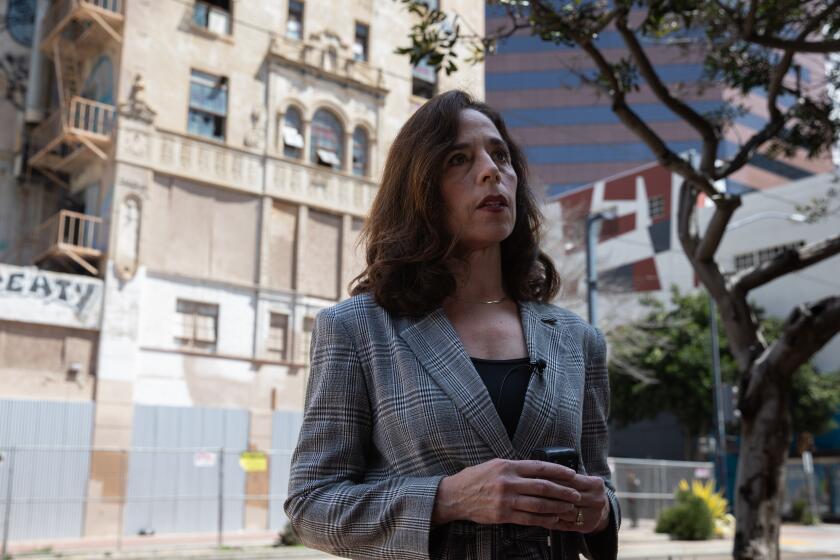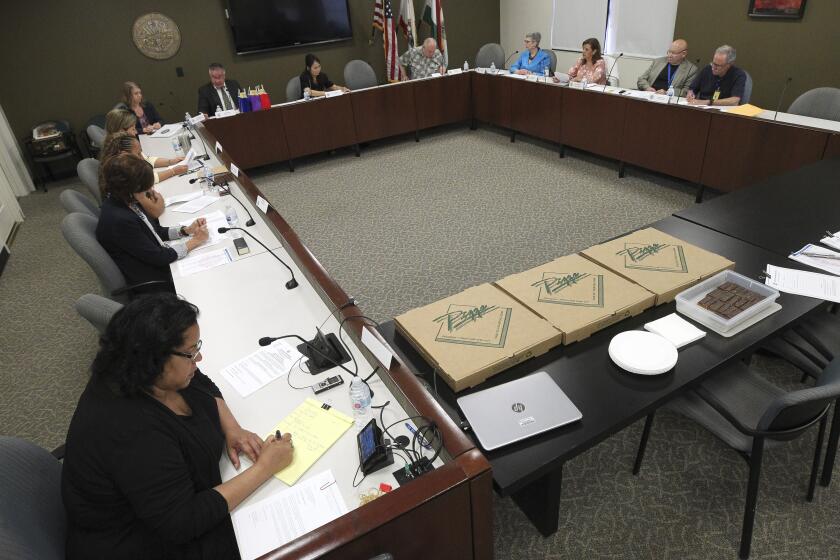Money meant for inmate welfare spent on education, staff, and sheriff’s department expenses

San Diego County inmates and their families spend millions of dollars a year on telephone calls and merchandise from jail commissaries. Breakfast gift packs are $14.99. A See’s Candies peanut butter egg goes for $6.99. A 15-minute phone call runs almost $5.
Last year more than $6 million in profit was raised through these phone calls and commissary sales at the county’s seven detention centers. The profits go into a special “inmate welfare” fund created to improve the quality of life behind bars, help rehabilitate inmates and keep them from returning to jail after release.
Records show that millions of those dollars also pay for county staff and jail operations, and millions more is saved in a reserve fund that has grown to almost double the amount raised from inmates each year.
When an audit recommended changes to how the inmate welfare fund is implemented, the sheriff’s office balked at a suggestion meant to increase public input.
The Sheriff’s Department, which has an operating budget of more than $900 million, issued a statement saying the inmate welfare fund spending is appropriate. The law establishing the fund gives the sheriff broad leeway in how to spend it.
But some critics say more should be directed toward programs that benefit inmates.
“There’s plenty of other things they could spend the money on to really help,” said Jared Moten of the San Diego chapter of the National Action Network civil rights group. “They could expand education. They could expand job-preparedness programs to help these men when they come out and they could even add counseling and mental health.”
According to the Sheriff’s Department, which is required to provide an accounting to the county Board of Supervisors every year, 71 percent of the $7.2 million spent from the fund in 2017-18 went to educational programming.
The education spending included just over $2 million for “contracted services” from school districts and nonprofits, including computer literacy courses, high school and college classes, vocational education and mental health counseling, records show.
A fraction of the 5,500 jail inmates partake in the programs. The department said 158 inmates completed high-school equivalency requirements, 322 passed college-level courses, 1,155 enrolled in anger-management programs, 804 took food handling and culinary arts, and 440 participated in a “healthy relationship” program.
More detailed records obtained by The San Diego Union-Tribune show $3 million of the $5.2 million reportedly spent on academic and other programs paid for employee salaries and benefits, including those for the Detentions Bureau sergeant, six deputy sheriffs and various managers, clerks, assistants, eight correctional counselors, a reentry services manager, and temporary workers.
The department also relied on phone and commissary profits to pay other seemingly routine department expenses.
For example, records show the Sheriff’s Department used $79,000 from the fund to maintain vehicles, $61,600 for office expenses, $21,890 for vehicle fuel, $10,800 on data processing equipment, $7,450 on trash service and $93,300 on unspecified “minor equipment,” records show.
The Sheriff’s Department said in a statement that its spending is appropriate and legal.
“It is the policy of the sheriff of San Diego County to promote economy, efficiency, and effectiveness in the procurement of property and services for the inmates,” the department said. “Expenditures of Inmate Welfare Special Revenue Fund resources will be in accordance with the provisions of Section 4025 of the California Penal Code.”
The penal code says the money shall be expended by the sheriff “primarily for the benefit, education, and welfare of the inmates confined with the jail.” But any funds “not needed” for the welfare of inmates may be spent maintaining jail facilities. That may include salary and benefits for personnel who work in programs that benefit inmates such as education, drug and alcohol treatment, welfare, library, accounting and other programs deemed appropriate by the sheriff.
However, the funds are not supposed to be used for “required county expenses of confining inmates,” including meals, clothing, housing, and medical services.
Records show the department last year used $9,970 from the fund for out-of-county travel, $3,440 for cell phones and $411 for hazardous materials.

Profiting from inmates
The inmate welfare fund report Sheriff Bill Gore sent to county supervisors for the year ending June 30, 2018 identified $2.1 million in non-education spending, including overhead costs and programs that directly benefit prisoners.
Specifically, $608,000 paid for administrative staff and $530,000 was spent on operations and support, the report said. That left $325,000 for “free indigent goods,” $368,000 for supplies, $195,000 for entertainment and recreation and $66,000 for equipment.
The Sheriff’s Department also invested $165,000 in books and publications and $282,000 in inmate travel vouchers.
The Union-Tribune requested the inmate welfare records earlier this year, after a Massachusetts advocacy group, Prison Policy Initiative, found that local jails charge excessive rates for inmate telephone calls. San Diego County, for example, charged inmates almost $5 for a 15-minute call, according to the survey.
“At a time when the cost of a typical phone call is approaching zero, people behind bars in the U.S. are often forced to pay astronomical rates to call their loved ones or lawyers,” the authors wrote.
Sheriff’s officials said their agreement with Securus Technologies means inmates here pay a fair price for phone use, and the proceeds pay for inmate services the county couldn’t afford otherwise.
“Our existing contract to provide inmate telephone services was negotiated in good faith, provides the lowest possible rates and includes collect, debit and prepaid options,” the department said.
The San Diego Sheriff’s Department operates its own network of in-jail kiosks that sell everything from combs to toiletries to candy. Inmates or their relatives deposit money into a personal commissary account, each time paying a non-refundable fee of $3.25.
According to the county budget, the sheriff’s commissary program raises and spends about $10 million a year. Profits of $750,000 to $1 million per quarter are deposited into the inmate welfare fund.
Katarina Boudreau, a San Diego woman who served five months in the Las Colinas Detention and Reentry Facility in 2016, said the commissary charges $4 for a motel-sized stick of deodorant and $3 for a small bag of potato chips.
“Everything is up-priced,” she said. “Everything is super expensive.”
Boudreau, now a student at Mesa College, said the Sheriff’s Department should spend more of that money on programs for inmates.
“We sit in our cells all day for the most part,” she said. “All anybody wants is something to do, a class, anything.”
The sheriff’s committee
The inmate welfare fund is overseen by a committee of public-safety officials that meets monthly to determine how the money should be spent. The panel includes a dozen sheriff’s officials -- and one representative of the public.
In 2016, after the grand jury recommended a closer look at the inmate welfare fund, the county Office of Audits and Advisory Services released an 11-page review that included six findings and some recommendations to correct them.
Specifically, auditors said the Sheriff’s Department improperly spent $90,000 of the inmate welfare fund on new toilets for a recreation yard upgrade at the George Bailey Detention Facility.
“This expense is arguably a required expenditure pursuant to the requirements of Title 15, which outlines rules and regulations for adult institutions, programs and parole, and Title 24, which stipulates recreation yard guidelines,” the audit said.
Sheriff’s officials said in a response to the auditors that the $450,000 renovation would have been delayed if they had gone through the process of tapping into the department’s general fund for the $90,000 toilets.
The audit also found some expenses were not properly approved; the department lacked written policies and procedures for reconciling transfers of commissary profits; and the department had insufficient controls over equipment purchases and other fixed assets.
The Sheriff’s Department said it corrected all the deficiencies and implemented all the recommendations but one: it declined to increase participation of private citizens on the inmate welfare committee.
“The recommendation will not be implemented because it is not warranted,” the department’s statement said. “The inmate welfare committee currently meets the established requirements of one civilian volunteer that is appointed by the sheriff.”
$13 million in reserve
Gore appointed Burma Dunn of Chula Vista as the public representative on the inmate welfare committee.
A retired operations supervisor with AT&T who previously served on the San Diego County grand jury, Dunn declined to discuss her role on the committee, its spending decisions or the sheriff’s handling of the inmate welfare fund.
“I am a public representative on the board, but that does not mean I am authorized to speak for the board,” said Dunn, 79.
While the fund summaries distributed to the Board of Supervisors omit mention of reserve cash, internal records show the department is banking millions of dollars generated by jailhouse phone calls and commissary sales.
The welfare fund balance stood at $13.4 million at the end of June -- three times the reserve required by committee policy, which says 50 percent of the fund’s operating budget must remain on deposit.
Moten, the local National Action Network leader who also is the senior pastor at Ebenezer Missionary Baptist Church in Shelltown, said Gore should recruit more public voices to the inmate welfare committee to generate fresh ideas for spending the money and to avoid conflicts of interest.
He also said more of the commissary and phone profits should be used to prepare inmates for their return to society.
“By not utilizing that money in a more effective way, they are adding to the recidivism,” Moten said.
Christine Brown-Taylor, a member of the inmate welfare committee who manages re-entry services for the sheriff, said the group is working to increase services available to inmates.
“We have begun spending down the available fund balance on new program contracts,” she said, “and (we) will be spending more fund balance this fiscal year on expanding vocational programs and vocational equipment needs.”
Brown-Taylor said the Sheriff’s Department has to be careful about not adding programs too fast.
“The reserve is there to ensure that we can continue to provide these essential educational, vocational, and psychosocial programs in the event of potential loss of revenue and any changes in legislative policy,” she said.
Get Essential San Diego, weekday mornings
Get top headlines from the Union-Tribune in your inbox weekday mornings, including top news, local, sports, business, entertainment and opinion.
You may occasionally receive promotional content from the San Diego Union-Tribune.












